Keloids on the Ear
Keloids occurring over the ear are very common. At Rejuvence Clinic we get a large number of clients presenting to us looking for treatment for their ear keloids, especially following piercings that have subsequently got infected or they have reacted to jewellery. At Rejuvence, we are able to offer both conservative and surgical treatment options for ear keloids. Surgical treatments comprise of excision of ear keloids with reconstruction, followed by a combination of steroid injections, silicon gel, and keloid compression earrings. To date we have been able to successfully achieve a very low recurrence rate.
What are keloids?
Keloids or keloid scars develop as a result of an overgrowth of collagen within cuts or wounds. They can also occur after treatments such as aggressive lasers or deep chemical peels. Keloids are defined as raised scars that extend beyond the borders of the original cut or wound. They can grow to significant size and can often also be associated with itching and peeling. They can be very challenging to treat and are often associated with a significant rate of recurrence.
Why do keloids form on the ear?
The vast majority of keloids that form on the ear are the result of ear piercings. Often keloids can form where a piercing has not been carried out properly and results in infection. Keloids can also form when there is a reaction to jewellery worn. Piercings involving cartilage can result in larger and more aggressive keloids than those that form on the earlobe. ‘Industrial’ piercings or ‘Bars’ can be particularly troublesome and quite often cause keloids.
Many of our clients ask if getting their ears pierced using a gun as opposed to a needle results in a higher risk of keloid formation. It’s unclear, but from what we have seen, it looks like keloids have a higher risk of occurring where the piercing is not carried out properly, especially when a gun is used instead of a needle. Keloids on the ear also form following surgery such as a pinnaplasty (pinning your ears back), or following harvesting of cartilage for use in other procedures, such as a rhinoplasty.
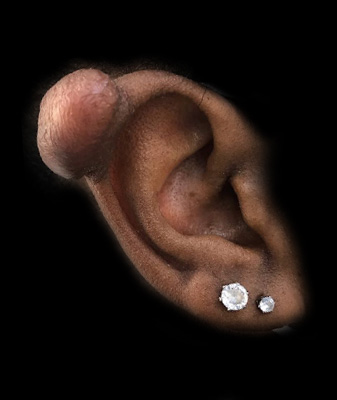
Who are most likely to develop keloids?
As with keloids occurring elsewhere on the body, Afro-Carribeans, Asians as well as certain Mediterranean groups are more at risk of keloid formation, especially following a piercing. However, this does not mean that other ethnic groups don’t develop keloids on the ear. Keloids on the ear tend to occur with higher frequency in a wider spectrum of people. Hence it is very important to make sure you get your ears pierced at a reputable piercing store as complications from an ear piercing can significantly increase your risk of developing a keloid irrespective of your ethnic background.
Where is your keloid?
Ear Keloid Treatments
As with keloids elsewhere on the body, there are a number of treatment options available. However, it is extremely important to realise that in keeping with keloids elsewhere, keloids on the ear, do you have a high rate of recurrence, and hence prevention is always better than cure. Treatment should be followed by careful monitoring of any recurrence with quick pre-emptive treatment where necessary in order to prevent the keloid from coming back with a vengeance.
Steroid Injections
Intralesional steroid injections have been regarded as first-line treatment for keloids, especially those on the ear. Injection of steroid into keloid scars results in breakdown of the fibrous collagen as well as potential prevention of further growth. In the case of larger keloids, a series of intralesional injections may be necessary spaced out over a period of 8 to 12 weeks.
A recent new innovation is the combination of Target Cool with intralesional steroid injection. Target Cool can successfully reduce the pain of the injection by almost 80%.
We have found that the use of steroids for the treatment of ear keloids can be slightly limiting. With smaller keloids measuring less than 5mm in size, they can work extremely well resulting in more than 50% improvement. With larger keloids on the ear, the steroids can help soften the fibrous scar tissue but with much less reduction in size and improvement in contour. However, due to the nature of the shape and skin coverage of the ear, larger keloids can permanently disrupt the shape of the ear and often some sort of reconstructive surgery is required for the best cosmetic results.
Steroids are associated with risks and complications. Atrophy of the skin and underlying fat can occur following a series of injections. Atrophy means breakdown or loss of soft tissue (usually fat) resulting in thinning and ‘pouring’ off the skin. This can take time to occur and initially it may seem the treatment is working extremely well. However, due to crystallisation of steroid droplets in the scar, the effect of the steroid can carry on for longer than expected and results in ‘pitting’ of scars as opposed to just flattening. In addition there can also be hypopigmentation due to prevention of melanin production. Normally both these complications do resolve but can take many months and even more than a year. Overall however, the rate of occurrence of such complications with ear keloids tends to be slightly less than with keloids elsewhere on the body.
5-FU and Wrinkle Relaxation Injections
More recently research has shown that 5–FU (a chemotherapy drug) used as an intralesional injection can also significantly reduce the size of keloids. Combination of 5-FU with steroid has been shown to be more effective than steroid on its own, especially where keloids are tending to be quite stubborn, and not particularly responsive. The incidence of atrophy and hypopigmentation is also much less with 5-FU. However, 5-FU as a single drug on it’s own is not as effective as steroids. Wrinkle relaxation medication can also be injected into Keloid scars, and has also been shown to result in a reduction in size. From our experience, intralesional steroid injections are usually sufficient on their own for the reduction in size of ear keloids, as well as prevention following definitive treatment in the form of surgery.
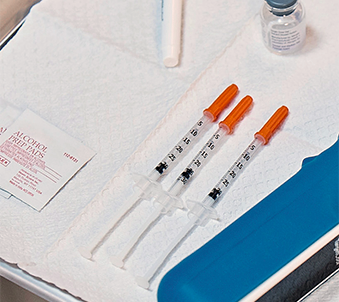
Cryotherapy
Cryotherapy involves using nitrous oxide to freeze Keloid scars. Keloid scars on the ears can be sprayed using cryotherapy and for smaller lesions they can achieve some reduction in size. Cryotherapy often needs to be combined with another treatment such as Intralesional steroids to make results occur faster and prevent recurrence. For larger keloids some clinicians prefer a technique known as Intralesional cryotherapy. This is where the cold nitrous oxide is injected under pressure into the Keloid scars much like Intralesional steroid injections. The cold nitrous oxide breaks down the scar from the inside. Although this is effective at fast reduction in size for larger keloids the effects are slow and painful. In addition cosmetic results are not the best and rate of recurrence is still significant often with colour changes to the skin.
Keloid Compression Earrings
The use of compression to reduce the size of keloids has been a technique that has been quite successful, especially with ear keloids. Compression of smaller keloids, or following surgical removal of keloids can result in reduction in size as well as prevention of recurrence. A number of studies have been published, whereby researchers have found that those using Compression earrings, following surgical removal of keloids or alongside treatment with intralesional steroid injections had better results and a much lower rate of recurrence.
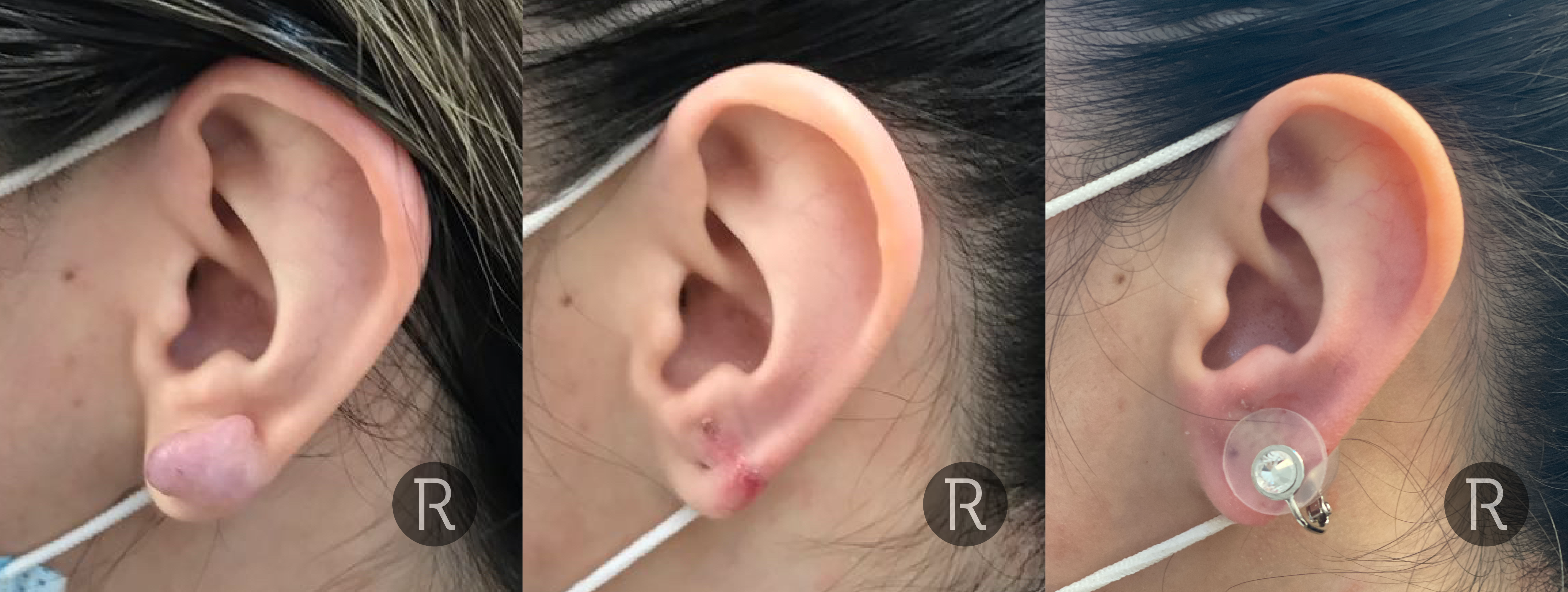
©Individual results may vary.
At Rejuvence, we supply a compression earring to all our patients that undergo surgical removal of their keloid scars. We usually advise wearing these for 6 to 8 hours a day for at least 18 to 24 months. We have researched the market and sourced excellent compression earrings that are comfortable and easy to wear. There are other clinics that do provide compression earrings, but these usually have a screw type mechanism that is normally very difficult to apply and not particularly durable. We do sell the compression earrings separately if required.

Surgery

From our experience at Rejuvence clinic we have found that the majority of ear keloids require surgical excision and some form of reconstructive surgery in order to achieve the best cosmetic result. Surgery for keloids is traditionally associated with a high recurrence rate and many doctors will advise not bothering with surgery as it will almost inevitably make things worse.
This is NOT correct. On certain regions of the body, we would definitely advise against taking a surgical approach as there is likely to be significant recurrence for example on the chest and shoulders. However, even in these cases there are times when surgery is completely appropriate. When it comes to keloids on the ear, we believe, and from our results have shown, that surgery is an excellent option and almost always will deliver the best cosmetic result.
The success of surgery is dependent on using the correct surgical technique, the skill of the surgeon, and the need to combine surgery with other preventative treatments in an attempt to reduce the rate of recurrence such as steroid injections and compression earrings.

Flexible payment options for surgical treatment – 0% APR available. Spread the cost of your treatment today!
Terms and Conditions apply. *Acceptance subject to credit status.

Flexible payment options for surgical treatment – 0% APR available. Spread the cost of your treatment today!
Terms and Conditions apply. *Acceptance subject to credit status.
Shave Excision
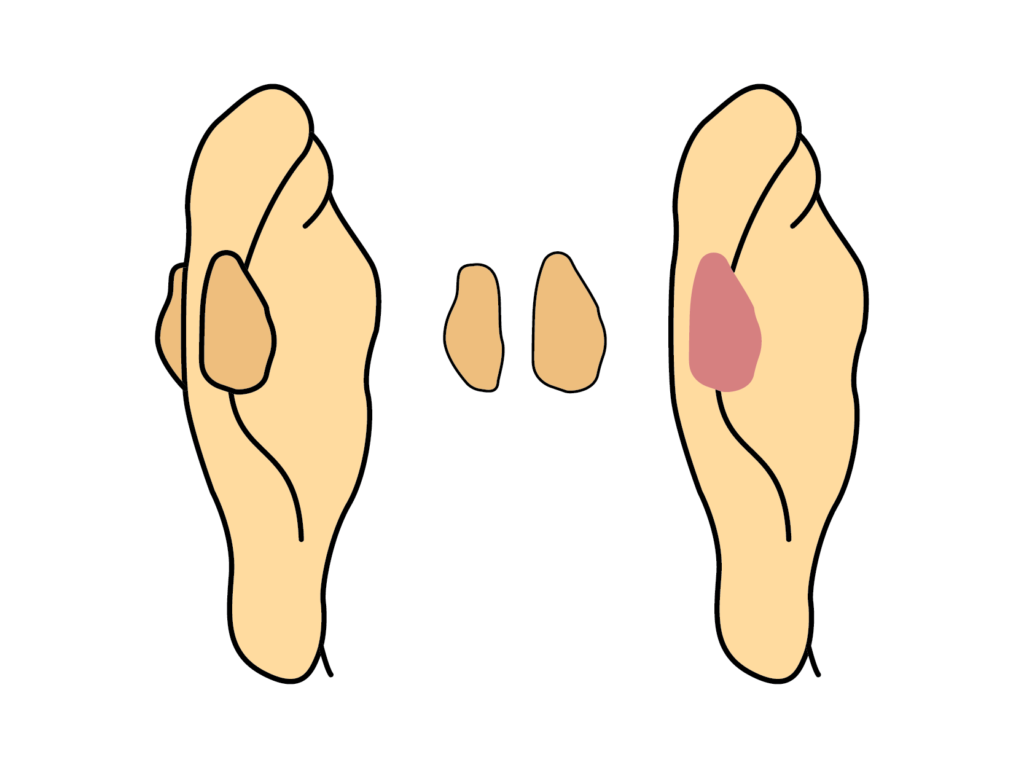
A very popular surgical technique used for the excision of keloid scars, especially on the ear is a shave excision using a cauterisation device (some clinics refer to this as a ‘laser’). A shave excision involves cutting away the keloid from the base, leaving behind an open wound that is left to heal by itself over a few weeks – also known as healing by secondary intention. The advantages of this technique are that it is quite straightforward and quick to carry out. However, total recovery time is quite long with a poor cosmetics scar and a high rate of recurrence.
With regards to keloids on the ear, following a shave excision, there is almost always a significant amount of keloid scar tissue left behind at the base of the excision site within the ear. Some suggest a theory that leaving behind some keloid scar tissue may actually result in a lower chance of recurrence as the body recognises that there is keloid tissue present and hence does not initiate further new keloid formation despite surgery. However, recurrence rates following a shave excision are still quite high.


Flexible payment options for surgical treatment – 0% APR available. Spread the cost of your treatment today!
Terms and Conditions apply. *Acceptance subject to credit status.
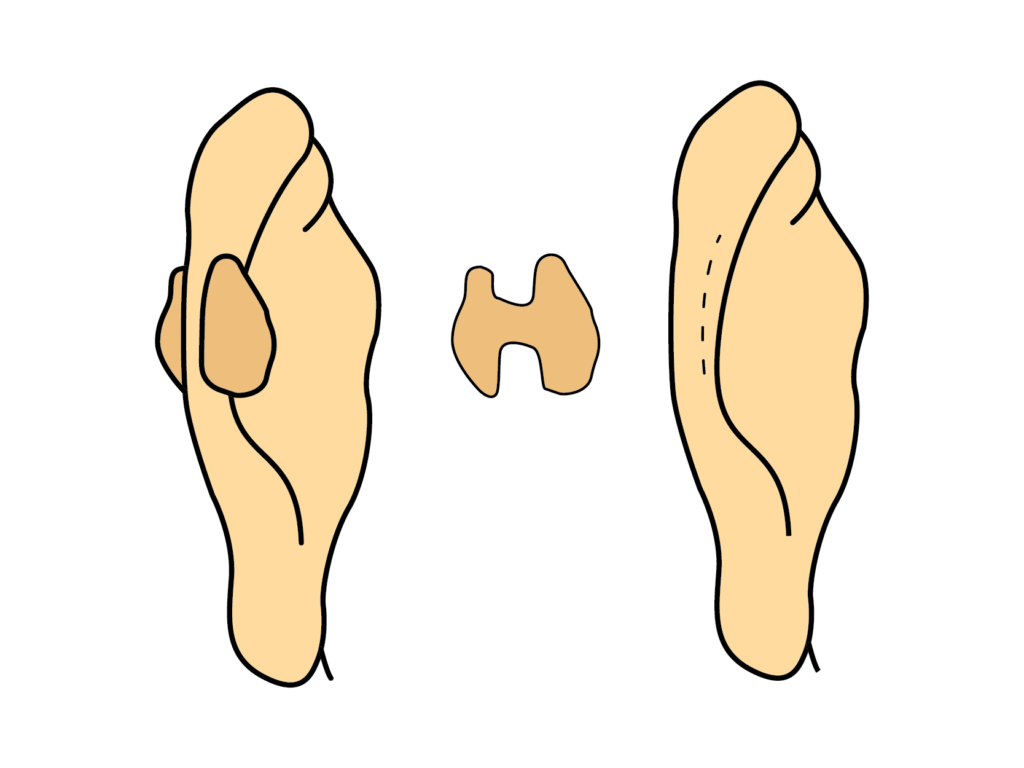
Core Excision with Reconstruction

At Rejuvence, we favour a technique known as a core excision followed by surgical reconstruction. We have found over the last three years that our recurrence rates are extremely low with this approach and have managed to achieve excellent cosmetic results.
A ‘Core Excision’ involves removing all keloid tissue, including scar tissue below the skin of the ear and lying adjacent to and/or within the cartilage of the ear as well as on the surface. This approach aims to remove as much of the keloid as possible. When combined with silicon gel massage, steroid injections and a keloid compression earring, we have achieved excellent recurrence rates that are currently below 3%.
Following the excision, we carry out reconstructive surgery to ensure we are able to provide the best cosmetic result.

Flexible payment options for surgical treatment – 0% APR available. Spread the cost of your treatment today!
Terms and Conditions apply. *Acceptance subject to credit status.
Rejuvence 3-STEP Approach
At Rejuvence, we specialise in the treatment and surgical removal of keloid scars on the ear. We have had excellent results. We use a three-step process to ensure the best cosmetic result for our patients.
STEP 1: Core Excision & Reconstruction
Following your initial consultation, we will schedule surgery and carry out a core excision of the keloid scar followed by reconstruction of your ear. The aim of this approach is to ensure that we remove as much of the keloid as possible. We follow this up with excellent reconstruction to ensure you get the best cosmetic result. The surgery is carried out under local anaesthetic which involves a few stinging injections around the keloid. This usually takes around 30 to 45 seconds to administer following which you won’t feel a thing and the anaesthetic, normally lasts for at least 2 to 3 hours. Following surgery, we advise all of our clients to ensure they keep the ear dry and away from water. This is extremely important to prevent the risk of any infection. Infection will significantly increase the risk of recurrence.
STEP 2: Removal of stitches followed by steroid injection
Two weeks following surgery we will schedule an appointment for the removal of stitches and a review of the scar. At this point, we will normally advise continuing to keep the ear dry for a further five days and apply Vaseline twice a day to keep it hydrated and moisturised. From three weeks following surgery, it should be possible to start to get the ear wet and have normal showers. At four weeks we will administer an Intralesional steroid injection.
STEP 3: Silicon Gel Massage & Keloid Compression Earring
Four weeks after your surgery and having completed the steroid injection, we advise all of our patients to apply silicon gel massage for the first six months and wear our keloid compression earring for at least 6 to 8 hours a day for the next 18 to 24 months.
Ear Keloid Revision Surgery
At Rejuvence we have a lot of experience in carrying out Keloid treatments for clients who have had previous surgery for their ear keloids but unfortunately have suffered a recurrence. Often this can result in keloids that are larger than before and the shape and architecture of the ear can be significantly altered. Poor or inappropriate surgical techniques used in previous surgical attempts can also negatively impact on any recurrence. All these reasons put together can make revision Surgery quite challenging.
At Rejuvence we are very happy to take on revision cases and have an extensive portfolio of successful outcomes. The key to a successful revision procedure with positive long term outcomes is to be committed to the prescribed aftercare and to ensure we arrange regular follow-ups.
At the slightest suggestion of recurrence, such as swelling over the scars, it is essential that intralesional steroid injection therapy is restarted and to have a low threshold to incorporate 5-FU as well.
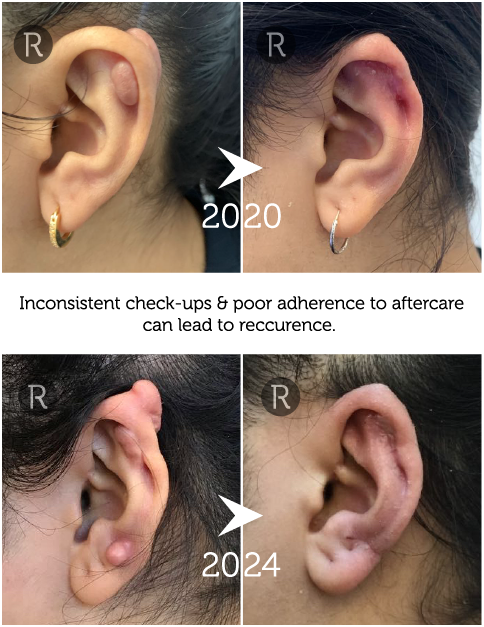
©Individual results may vary.

Flexible payment options for surgical treatment – 0% APR available. Spread the cost of your treatment today!
Terms and Conditions apply. *Acceptance subject to credit status.

Flexible payment options for surgical treatment – 0% APR available. Spread the cost of your treatment today!
Terms and Conditions apply. *Acceptance subject to credit status.
What do I do if I am worried my keloid is coming back?
In addition to ensuring the best possible cosmetic outcome, the key to preventing future repeated recurrence is to preempt this by following all the aftercare advice including silicone gel massage and keloid compression earrings. We advise all our clients to contact us immediately if they are concerned their keloids may be coming back so that we can quickly assess and treat before any significant escalation. This usually involves an intralesional steroid injection that, in the early stages, can successfully prevent any noticeable recurrence. Our responsive WhatsApp service enables all our clients, old and new, to contact us quickly and easily to share any concerns regarding their ear keloids with our doctors and if needed we will always get our old clients in as soon as possible for a review FREE of charge.
New piercing after Ear Keloid Surgery
Many patients ask us about whether they can re-pierce their ears following the surgical removal of their keloids. In short, after ear keloid surgery we strongly advise against getting your ears re-pierced through the same areas. Keloid recurrence is almost inevitable and likely to be more aggressive. In certain cases where clients are desperate to retain their ear piercings in a keloid inflicted earlobe we can incorporate a new piercing into your keloid ear surgery. We do this by suturing in a plastic ear stud and keep this in place for 4 weeks by which time the new piercing will have healed.
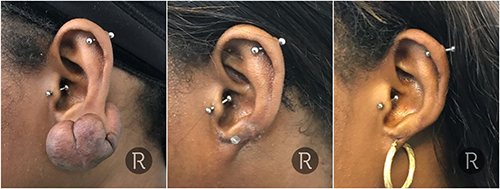
©Individual results may vary.
However, it is very important that extra care is taken. We advise clients to ensure only high quality gold or silver jewellery is subsequently worn to avoid potential allergic reactions. We also advise earrings are only worn on special occasions to prevent unnecessary trauma and irritation to the ear should jewellery need to be removed and replaced on a daily basis in order to maintain regular use of the compression earring.
What should I do if I notice a keloid growing around my piercing?
After getting new piercings or changing earrings it is good practice to keep an eye on the piercing to look for the development of any swelling that could turn into a keloid. If you do find a keloid developing it can be very difficult to decide whether to take the piercing out or not.
Sometimes taking the piercing out can result in swelling improving especially if there is an infection or the ear is reacting to the earring itself. Removing the earring results in improvement in infection or inflammation and hence improvement in the swelling. If the developing swelling is already an established Keloid, removing the earring can result in the Keloid growing at a faster rate. However, if you don’t remove the earring but also don’t get any treatment immediately the Keloid can continue to grow and the earring can get trapped within it and need surgery to remove it.
At Rejuvence we advise all our clients to get swellings examined and treated as soon they appear to avoid complications of a keloid.













